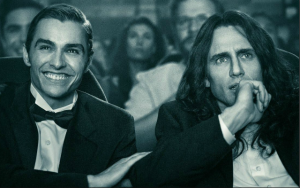LOOKING BACK AT 2017: RICHARD picks for the BEST FILMS OF THE YEAR.
 THE GOOD (in alphabetical order)
THE GOOD (in alphabetical order)
Baby Driver: Although it contains more music than most tuneful of movies “Baby Driver,” the new film from director Edgar Wright, isn’t a musical in the “West Side Story,” “Sound of Music” sense. Wallpapered with 35 rock ‘n roll songs on the soundtrack it’s a hard driving heist flick that can best be called an action musical.
The Big Sick: Even when “The Big Sick” is making jokes about terrorism and the “X-Files” it is all heart, a crowd-pleaser that still feels personal and intimate.
Call Me By Your Name: This is a movie of small details that speak to larger truths. Director Luca Guadagnino keeps the story simple relying on the minutiae to add depth and beauty to the story. The idyllic countryside, the quaint town, the music of the Psychedelic Furs and the languid pace of a long Italian summer combine to create the sensual backdrop against which the romance between the two blossoms. Guadagnino’s camera captures it all, avoiding the pitfalls of melodrama to present a story that is pure emotion. It feels real and raw, haunted by the ghosts of loves gone by.
Darkest Hour: This is a historical drama with all the trappings of “Masterpiece Theatre.” You can expect photography, costumes and period details are sumptuous. What you may not expect is the light-hearted tone of much of the goings on. While this isn’t “Carry On Churchill,” it has a lighter touch that might be expected. Gary Oldman, not an actor known for his comedic flourishes, embraces the sly humour. When Churchill becomes Prime Minister his wife, Clementine (Kristin Scott Thomas) makes an impassioned speech about the importance of the work he is about to take on. He raises a glass and, cutting through the emotion of the moment, says, “Here’s to not buggering it up!” It shows a side of Churchill not often revealed in wartime biopics.
The Disaster Artist: The key to pulling off “The Disaster Artist” is not recreating “The Room” beat for beat, although they do that, it’s actually about treating Wiseau as a person and not an object of fun. He’s an outrageous character and Franco commits to it 100%. From the marble-mouthed speech pattern that’s part Valley Girl and part Beaker from The Muppets to the wild clothes and stringy hair, he’s equal parts creepy and lovable but underneath his bravado are real human frailties. Depending on your point of view he’s either delusional or aspirational but in Franco’s hands he’s never also never less than memorable. It’s a broad, strange performance but it may also be one of the actor’s best.
Dunkirk: This is an intense movie but it is not an overly emotional one. The cumulative effect of the vivid images and sounds will stir the soul but despite great performances the movie doesn’t necessarily make you feel for one character or another. Instead its strength is in how it displays the overwhelming sense of scope of the Dunkirk mission. With 400,000 men on the ground with more in the air and at sea, the sheer scope of the operation overpowers individuality, turning the focus on the collective. Director Christopher Nolan’s sweeping camera takes it all in, epic and intimate moments alike.
The Florida Project: This is, hands down, one of the best films of the year. Low-budget and naturalistic, it packs more punch than any superhero. Director Sean Baker defies expectations. He’s made a film about kids for adults that finds joy in rocky places. What could have been a bleak experience or an earnest message movie is brought to vivid life by characters that feel real. It’s a story about poverty that neither celebrates or condemns its characters. Mooney’s exploits are entertaining and yet an air of jeopardy hangs heavy over every minute of the movie. Baker knows that Halley and Moonie’s well being hangs by a thread but he also understands they exist in the real world and never allows their story to fall into cliché.
Get Out: This is the weirdest and most original mainstream psychodrama to come along since “The Babadook.” The basic premise harkens back to the Sidney Poitier’s classic “Guess Who’s Coming to Dinner.” In that film parents, played by Spencer Tracy and Katharine Hepburn, have their attitudes challenged when their daughter introduces them to her African American fiancé. The uncomfortable situation of meeting in-laws for the first time is universal. It’s the added layers of paranoia and skewered white liberalism that propels the main character’s (Daniel Kaluuya) situation into full-fledged horror. In this setting he is the other, the stranger and as his anxiety grows the social commentary regarding attitudes about race in America grows sharper and more focussed.
Lady Bird: Greta Gerwig’s skilful handling of the story of Lady Bird’s busy senior year works not just because it’s unvarnished and honest in its look at becoming an adult but also, in a large degree, to Saoirse Ronan’s performance. I have long called her ‘Lil Meryl. She’s an actor of unusual depth, a young person (born in 1994) with an old soul. Lady Bird is almost crushed by the weight of uncertainty that greets her with every turn—will her parents divorce, will there be money for school, will Kyle be the boy of her dreams, will she ever make enough cash to repay her parents for her upbringing?—but Ronan keeps her nimble, sidestepping teen ennui with a complicated mix of snappy one liners, hard earned wisdom and a well of emotion. It’s tremendous, Academy Award worthy work.
The Post: Steven Spielberg film is a fist-pump-in-the-air look at the integrity and importance of a free press. It’s a little heavy-handed but these are heavy-handed times. Director Spielberg and stars Tom Hanks and Meryl Streep are entertainers first and foremost, and they do entertain here, but they also shine a light on a historical era whose reverberations are being felt today stronger than ever.
The Shape of Water: A dreamy slice of pure cinema. Director Guillermo del Toro uses the stark Cold War as a canvas to draw warm and vivid portraits of his characters. It’s a beautiful creature feature ripe with romance, thrills and, above all, empathy for everyone. This is the kind of movie that reminds us of why we fell in love with movies in the first place.
Three Billboards Outside Ebbing, Missouri: The story of a mother’s unconventional war with the world is simple enough, it’s the complexity of the characters that elevates the it to the level of great art.
Wonder Woman: Equal parts Amazon sword and sandal epic, mad scientist flick, war movie and rom com, it’s a crowd pleaser that places the popular character front and centre. As played by Gal Gadot, Diana is charismatic and kick ass, a superhero who is both truly super and heroic. Like Superman she is firmly on the side of good, not a tortured soul à la Batman. Naïve to the ways of the world, she runs headfirst into trouble. Whether she’s throwing a German tank across a battlefield, defying gravity to leap to the top of a bell tower, tolerating Trevor’s occasional mansplaining or deflecting bullets with her indestructible Bracelets of Submission, she proves in scene after scene to be both a formidable warrior and a genuine, profoundly empathic character.

